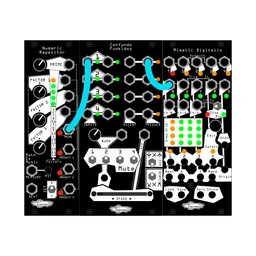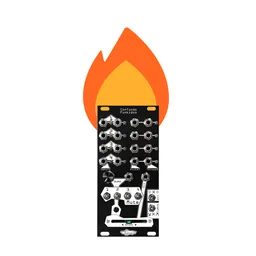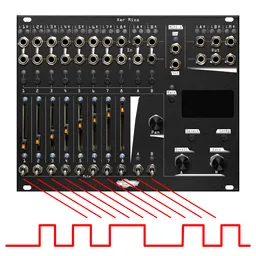I’m a big fan of patching together percussive sounds from scratch. For most of my time in Eurorack, I simply used filtered white noise as a sound source for hats in my patches. This has the advantage of being simple and easy to patch, but it’s hard to get any sort of timbral variety between patches, and it doesn't work as well for longer sounds like cymbals.
Today, we’ll explore a useful (and little-known) technique for creating metallic sounds using FM.
Analog hihats
Some early analog drum machines used filtered square waves to generate metallic noise. The Roland TR-808, for example, used 6 detuned square waves that were mixed then heavily filtered to create its cymbals. The square waves make a detuned smear of inharmonic noise that, when carefully filtered, sounds quite metallic.
While we could recreate the exact structure of the 808 cymbal for our patch, it would require 6 oscillators, 2 mixers, 5 filters, 3 VCAS, 3 envelopes… Even by my standards that’s a bit excessive.
So, let’s look at a slightly simpler way to create inharmonic noise: FM! Or PM, depending on the oscillators you use.
Hihats in Eurorack
If you’ve ever played with a complex oscillator (or done any sort of FM with two analog oscillators) you’ve probably heard some pretty wild and dissonant sounds before you got them in tune. In this patch, we’ll throw tuning and harmonic relationships to the wind – that sort of detuned, clangorous noise is exactly what we want for our hats. Using FM will allow us to use just two oscillators instead of six: our result will sound different from an 808, but it will still be a great metallic sound.
You’ll get the best results when using harmonically complex waveforms like saws and squares: when trying to create cleaner sounds using FM, sines and triangles are usually used… but we don’t want clean here.
Along with two oscillators, we’ll also need a few utilities to finish off our voice: a highpass filter to remove the fundamental frequencies of our oscillator, a VCA, and a decay envelope to control the dynamics of the sound.
Now that we have all the pieces of our patch, let’s connect everything together (and listen to some examples).
The hihat patch
The patch here is simple. First, we need to dial in our oscillators: I’m going to start out using a complex oscillator, the Loquelic Iteritas, in PM mode. By turning Morph all the way up, we have a pair of distorted saws that can modulate each other by adjusting the Modulate param to taste. Using a complex oscillator like Loquelic Iteritas has the advantage of only using a single module for sound generation, but any pair of oscillators with FM inputs could be used. Patch the square or saw out of one into the FM input of the other, and continue the patch from the second oscillator’s square or saw out.
Here’s what my oscillator sounds like, completely unprocessed:
While this is a cool sound on its own, this is not the metallic texture that we really want. To fix this, we just need to add some filtering: I’m using a relatively steep highpass filter (the Belgrad from XAOC), but a bandpass filter could be used instead to create a slightly different timbre.
Instantly, we have a much less tonal sound, perfect for cymbals, hihats, and anything else metallic your patch might need.
Lastly, we need to add in a way to control dynamics. I’m using a simple decay envelope from the Pons Asinorum to control the level of the Quantus Ampla VCA. Add in a trigger sequence and you’ve got your hats!

Variations, CV, and processing
There are many ways to create variations of this patch. Modulating the length of the decay envelope is the easiest way, and a simple CV signal like gates from a clock divider can be used to create alternating open and closed hihats. CV can also be used to change the frequency of the filter or of either of the oscillators to create timbral variety, too.
I often process hats and cymbals like this through a short reverb, too: I find it adds a more natural effect to their otherwise synthetic timbre.






